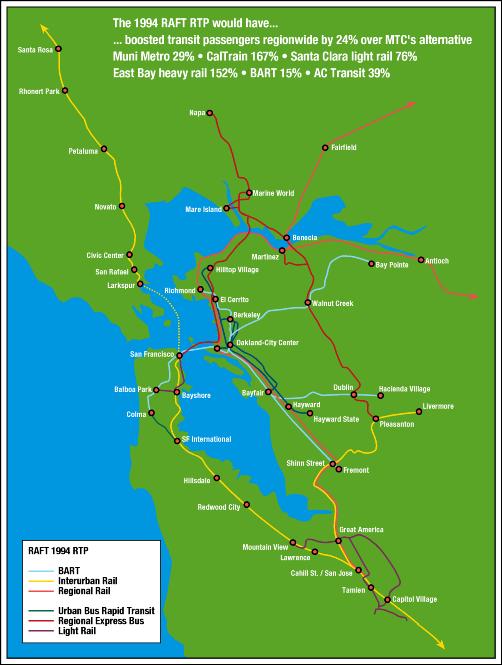

John Holtzclaw
MTC Calculates That Transit, With Infill, Beats Highways and Sprawl
In 1993-4 the Metropolitan Transportation Commission (MTC) developed a new Regional Transportaiton Plan (RTP). The Regional Alliance For Transit (RAFT)of transit and environmental activists, prepared a transit andland use alternative RTP for MTC to analyze with its own,conservative, modeling system. The results of that analysis are very instructive.
RAFT's alternative would have eliminated nearly all of the 500 miles of new freeway lanes around the region. Instead, it would have used the same total capital funding for transit, including electrifying the CalTrain from San Jose to San Francisco, extending it past its present San Francisco terminus a mile and a-half to the downtown Transbay Terminal, and operating it on BART schedules. Having improved CalTrain service to San Francisco Airport, RAFT would have eliminated the BART extension past Colma.
RAFT would have built light rail: Muni Metro on Third Street in San Francisco and in the Capitol and Tasman corridors in Santa Clara county. RAFT would have expanded heavy rail on existing tracks to link Santa Clara light rail and CalTrain to BART and on to Livermore, Sacramento and San Joaquin county. RAFT would have operated electric trolleybus service in the urban corridor between Hayward, Oakland and Richmond on East 14th St. and San Pablo Ave., operated express buses on I-80 and I-680, and commuter rail in Marin and Sonoma counties. It would have converted some freeway lanes to carpool lanes.
RAFT prescribed parking cash-out, whereby non-driving employees would receive the cash value of their unused "free" parking space - an idea included in Clinton's 1995 budget proposal. California counties have the authority to implement this proposal under Assemblyman Katz's 1992 law, AB 2109. County congestion management agencies can require employers to offer parking cash-out to all employees getting free or subsidized parking. CMAs can reduce employers' costs by reducing the parking spaces they are otherwise required to provide.
Further, RAFT used the same ABAG regional population and job projections as MTC, but clustered the growth around transit stations in city centers with urban services, avoiding the huge cost of building infrastructure on raw land. ABAG's land use policy framework and the Air District's model air quality element for cities specify just such development. RAFT saved some 200 square miles of forests, grasslands and farmlands that MTC's plan would have developed for residences, commerce, industry and local streets, mostly in eastern Alameda, Contra Costa and Solano counties, southern Santa Clara county and northern Sonoma and Napa counties. The roads, water, sewer, gas, electric, schools, fire stations and other infrastructure to develop that land would cost some $25 billion. RAFT would have saved most of that cost by directing development into already served areas.
MTC's analysis predicted that by 2010 RAFT's alternative would have held vehicular travel 6% below MTC's alternative, saving the average family 1,148 miles of travel annually, worth $379. RAFT would have saved 350,000 gallons of fuel daily. RAFT's alternative would have reduced pollutant emissions 1.8 tons/day of organics, 2.8 tons/day of NOx, 19 tons/day of CO, and 3.3 tons/day of particulates. RAFT would have cut326,000 vehicle "hours of travel" congestion daily, or 13%
Further, RAFT would have boosted transit passengers regionwide by 24% over MTC's alternative, boosted Muni Metro 29%, CalTrain 167%, Santa Clara light rail 76%, East Bay heavy rail 152%, BART 15% and AC Transit 39%.

Advantages of the RAFT RTP over MTC's Adopted RTP
Vehicle Miles of Travel
6% less
Annual automobile cost
$379 saving per household
Vehicle hours of travel (congestion)
13% less
Fuel consumption
9% savings
Emissions:
Carbon monoxide
6,900 tons in annual reductions
Reactive organic gases
660 tons in annual reductions
Nitrogen oxide
1020 tons in annual reductions
Particulates (PM10)
1200 tons in annual reductions
Development:
Regional population and job growth
No difference
Rural and natural land urbanized
200 sq. miles saved
Infrastructure costs for new development
Up to $25 billion saved
RAFT 2010 Transit Additions-
MUNI Metro Bayshore LRT Line
CalTrain electrification and extension to Transbay Terminal, with BART schedules and local express service
SFO People Mover, with CalTrain/BART transfer station, and express bus to Colma BART
Capitol Ave/Exp and Tasman LRTs, with Great America transfer station
Expanded Capitol Corridor (Amtrak) service, with Shinn St and Benecia transfer stations
Expanded San Joaquin (Amtrak) service
Tamien-Livermore commuter rail, with Shinn St (Fremont) transfer station to BART
Trolley buses on San Pablo (from Richmond), E 14 St, Telegraph Av, College Av, MacArthurm Av & Foothill Bl, with traffic light preemption, express & local service
I-80 Vallejo-SF express bus service
I-680 Vallejo-Pleasanton express bus service
I-680 Martinez-Pleasanton express bus service
NWP Larkspur-Sonoma commuter rail
Region-
19 miles of freeway lanes, compared to MTC's 500.







